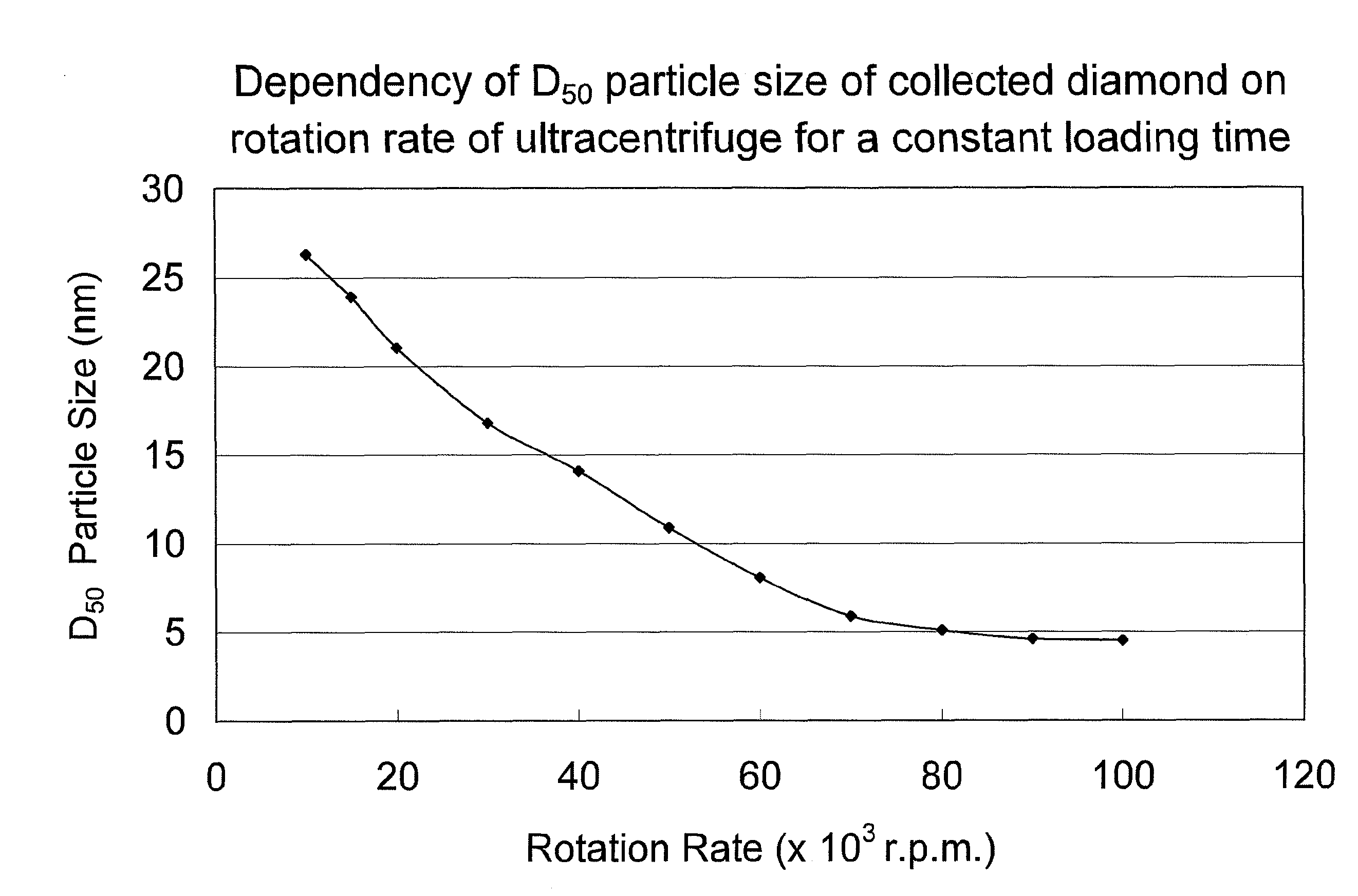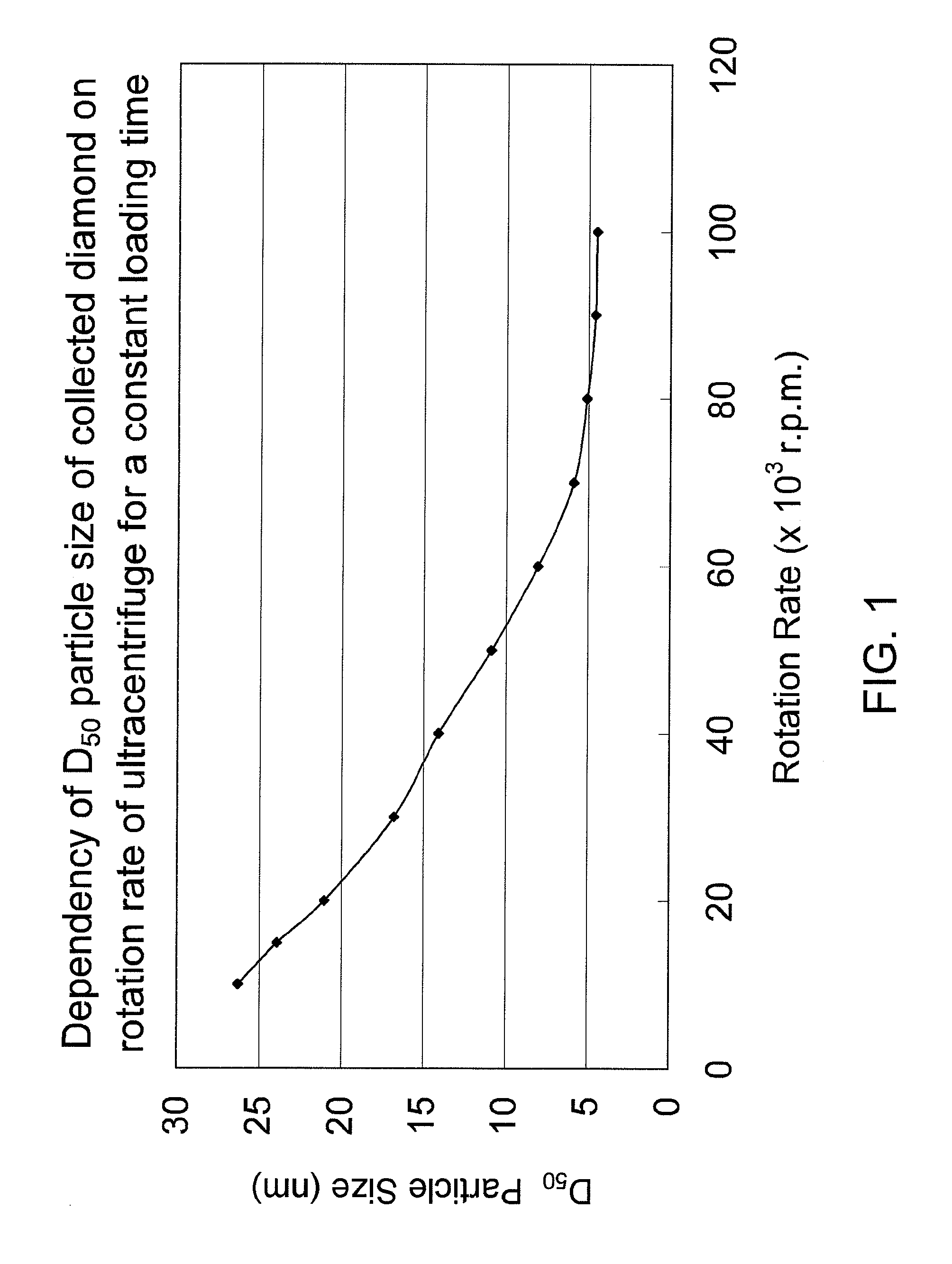Minute diamond powder, method for collecting the same and slurry comprisng the same in suspension
- Summary
- Abstract
- Description
- Claims
- Application Information
AI Technical Summary
Benefits of technology
Problems solved by technology
Method used
Image
Examples
example 1
[0040]A minute diamond powder was prepared from the starting material of single crystalline diamond, ball mill crushed product of static ultrahigh pressure synthesis. The starting material was first heat treated in mixed solution of hydrochloric and nitric acid, in order to remove by dissolving metallic impurities deriving principally from the milling balls. The diamond was then heated to around 300° C. in a 9:1 mixed solution of concentrated sulfuric acid and concentrated nitric acid, so that non-diamond carbon that coexisted was decomposed and, at the same time, hydrophilic functional groups were joined to the surface.
[0041]The diamond as so acid treated was fully washed and subjected to an elutriation in de-ionized water, whereby a fraction of 150 nm and larger was removed, and subsequently a three-staged centrifugal process, whereby a fraction of 50 nm and larger was removed by settling.
[0042]Then the effluent fluid of slurry was loaded for size sorting on a Beckman Coulter Opti...
example 2
[0046]A polycrystalline diamond powder was used as a starting material, which were an elutriation size sorted product, having a 180 nm average particle size, of dynamic compression conversion of 30 GPa from natural graphite. As well known particles in the form of secondary state, which each consists of firmly agglomerated fused smaller primary particles, they were subjected to planetary ball milling for crushing.
[0047]Similarly to the process of example 1, the crushed powder was treated in both mixed solution of hydrochloric acid and nitric acid, and then mixed concentrated nitric acid and concentrated sulfuric acid, in order to remove by dissolution metallic impurities as well as the non-diamond carbon exposed that has come to the surface. After fully washing diamond with de-ionized water, the resulting fluid that contained diamond in suspension was loaded in a centrifuge tube, and processed at a rotation rate of 50 thousand r.p.m., giving 136×103 G, for 10 minutes. As a result the...
example 3
[0048]A detonation diamond from Russia was employed as a starting material to be treated by the method of the invention. The diamond we acquired exhibited a D50 size of 2.9 μm by MICROTRAC UPA 150, which apparently reflected its firm agglomeration, was admixed with potassium nitrate, boiled in concentrated sulfuric acid, and then fully washed so as to be disintegrated into component particles. The particles were then loaded on a Beckman-Coulter Optima TL Ultracentrifuge, which was operated at 50 thousand r.p.m., giving 136×103 G, for 20 minutes, for the centrifugal process. The diamond particles in suspension in the slurry were evaluated by MICROTRAC UPA 150, and showed a D50 of 6.0 nm, D10 and D90 sizes of 3.1 and 10.7 nm, respectively.
PUM
| Property | Measurement | Unit |
|---|---|---|
| Fraction | aaaaa | aaaaa |
| Percent by mass | aaaaa | aaaaa |
| Magnetic field | aaaaa | aaaaa |
Abstract
Description
Claims
Application Information
 Login to View More
Login to View More - R&D
- Intellectual Property
- Life Sciences
- Materials
- Tech Scout
- Unparalleled Data Quality
- Higher Quality Content
- 60% Fewer Hallucinations
Browse by: Latest US Patents, China's latest patents, Technical Efficacy Thesaurus, Application Domain, Technology Topic, Popular Technical Reports.
© 2025 PatSnap. All rights reserved.Legal|Privacy policy|Modern Slavery Act Transparency Statement|Sitemap|About US| Contact US: help@patsnap.com



